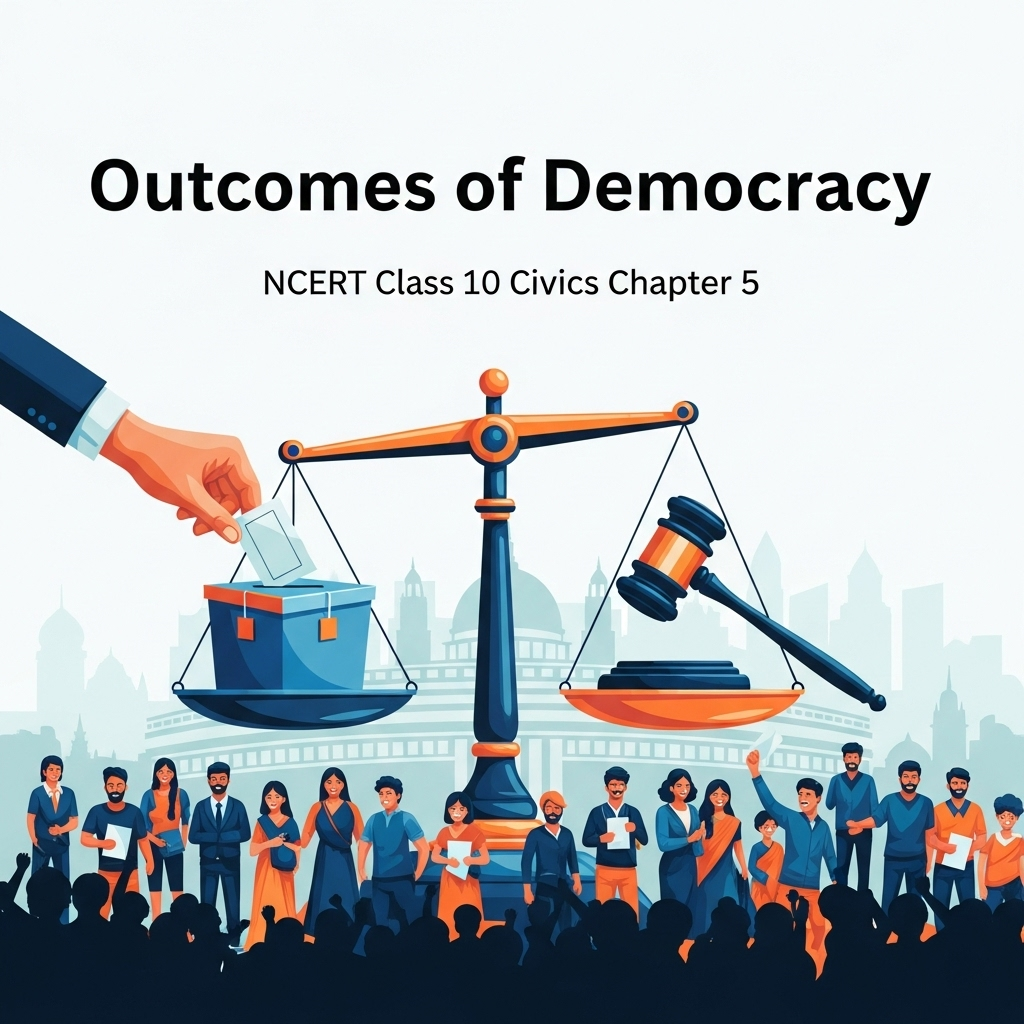Complete Solutions and Summary of Outcomes of Democracy – NCERT Class 10, Civics, Chapter 5 – Summary, Questions, Answers, Extra Questions
Comprehensive summary and explanation of Chapter 5 'Outcomes of Democracy', exploring the expectations and realities of democracy, criteria to measure democratic outcomes, analysis of government quality, economic well-being, social differences, inequality, conflict, freedom, and dignity—with all question answers and extra questions from NCERT Class X Civics.
Updated: 2 months ago
Categories: NCERT, Class X, Civics, Summary, Extra Questions, Democracy, Outcomes, Governance, Economic Well-being, Social Differences, Freedom, Dignity, Chapter 5

Outcomes of Democracy
Chapter 5: Civics - Complete Study Guide | NCERT Class 10 Notes & Questions 2025
Comprehensive Chapter Summary - Outcomes of Democracy Class 10 NCERT
Overview
- Chapter Purpose: Wraps up democracy tour by assessing outcomes. Asks: What does democracy do? What expectations? Fulfilled in reality? Covers quality of government, economic well-being, inequality, social differences/conflicts, freedom/dignity. Key Insight: Democracy is preferred but often dissatisfying in practice; invites thinking on moral/prudential reasons. Over 100 countries claim democracy, but differ in social/economic/cultural contexts. Democracy creates conditions; citizens achieve goals.
- Expanded Relevance 2025: With global democratic backsliding, focus on legitimacy, inequality; examples like South Asia surveys (2007). Update: Emphasize ongoing exams of democracy.
- Exam Tip: Use cartoons/graphs for analysis; distinguish expected vs actual outcomes.
- Broader Implications: Democracy's self-support; complaints show success in citizen empowerment.
How Do We Assess Democracy’s Outcomes?
- Recall from Class 9: Democracy better than alternatives (dictatorship/monarchy/military/religious rule) as it promotes equality, dignity, better decisions, conflict resolution, mistake correction. Cartoon: Coping with pressures/demands.
- Dilemma: Good in principle, not in practice; support exists but dissatisfaction common. Moral (intrinsic value) vs prudential (better outcomes) reasons.
- Global Context: Over 100 democratic countries with constitutions, elections, parties, rights; diverse situations mean varied achievements. Expect common outcomes from democracy as form.
- Realistic Expectations: Not panacea for socio-economic/political problems; form of government creating conditions, not guaranteeing solutions. Blame citizens if unmet, not idea.
- Assessment Approach: Examine expected/actual in government quality, economy, inequality, diversity, freedom/dignity.
Accountable, Responsive and Legitimate Government
- Core Expectations: People choose/control rulers; participate in decisions. Government accountable/responsive to needs/expectations.
- Efficiency Debate: Democracies slower due to deliberation/negotiation vs non-democratic quickness. But democratic decisions more acceptable/effective; cost of time worth it. Cartoon: Governmental secrecy.
- Transparency: Procedures/norms followed; citizens examine decisions (e.g., RTI). Missing in non-democracies.
- Mechanisms: Regular free/fair elections, public debate, information rights. Democracies succeed in elections/debate but fall short in fairness/sharing info.
- Substantive Aspects: Attentive to needs, corruption-free; record mixed, but better than non-democracies.
- Legitimacy: People's own government; overwhelming support globally (South Asia data: 88% suitability, 94% prefer elected rule). Graphs: Preference over dictatorship.
Economic Growth and Development
- Expectations: Good governments produce development; but many democracies fail.
- Evidence (1950-2000): Dictatorships slightly higher growth (4.42% vs 3.95%); negligible in poor countries (4.34% vs 4.28%). Not reject democracy; depends on population, global situation, cooperation, priorities. Cartoon: Rich get buff; gains uneven.
- Tables/Cartoon Analysis: Dictatorships better growth but inequalities high (e.g., South Africa/Brazil top 20% take 60%+ income). Democracies have inequalities; no clear superiority. Verdict: Prefer democracy for other positives.
Reduction of Inequality and Poverty
- Expectations: Reduce disparities; just distribution with growth.
- Reality: Political equality but growing economic inequalities; ultra-rich share increases, bottom incomes decline. Meet basics difficult. Cartoon: Voice of poor.
- Democracies' Record: Not successful; poor large voters but governments not keen (e.g., India poverty, Bangladesh half poor). Depend on rich countries for food.
- Majority Rule Myth: Poor majority, but not rule of poor; wealth not redistributed.
Accommodation of Social Diversity
- Expectations: Peaceful/harmonious life; accommodate divisions (e.g., Belgium success, Sri Lanka failure).
- Mechanisms: Procedures reduce tensions; respect/negotiate differences. Democracies best; non-democracies suppress. Cartoons: Enemies to greeting; effects on divisions.
- Conditions: Not majority rule alone; majority work with minority for general view. No permanent majorities; every citizen chance in majority (not barred by birth).
Dignity and Freedom of the Citizens
- Basis: Superior in promoting individual dignity/freedom; respect from fellows. Conflicts from unequal treatment.
- Achievements: Recognized in principle; degrees vary. Societies historically unequal (male-dominated, caste); struggles create sensitivity (women equal treatment, caste claims). Cartoon: Rosa Parks inspires.
- Legal/Moral Force: Easier in democracies; inequalities lack foundations.
- Ongoing Examination: Expectations/complaints show success; transforms subjects to citizens. Vote efficacy belief high (South Asia 65%). Graph: Vote difference.
SEO Note: Why This Guide?
Top-ranked for 'Outcomes of Democracy Class 10 notes 2025'—free, with 60 Q&A from PDF, quizzes. Integrates political insights.
Key Themes
- Expected vs Actual: Moral/prudential; legitimacy key outcome.
- Data/Examples: South Asia surveys, tables on growth/inequality.
- Critical Thinking: Why inefficiencies? Inequality persistence? Diversity accommodation conditions.
Cases for Exams
Analyze cartoons/graphs; discuss South Asia support; Nannu's RTI example.
Exercises Summary
- Focus: Expanded to 60 Q&A from PDF: 20 short (2M), 20 medium (4M), 20 long (8M) based on NCERT exercises + similar.
- Project Idea: Debate on assertions; analyze Nannu's case.
Group Discussions
No forum posts available.


